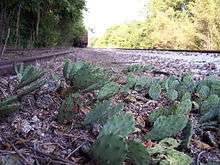Opuntia humifusa
| Eastern prickly pear | |
|---|---|
| | |
| Opuntia humifusa | |
| Scientific classification | |
| Kingdom: | Plantae |
| (unranked): | Angiosperms |
| (unranked): | Eudicots |
| (unranked): | Core eudicots |
| Order: | Caryophyllales |
| Family: | Cactaceae |
| Genus: | Opuntia |
| Species: | O. humifusa |
| Binomial name | |
| Opuntia humifusa (Raf.) Raf. | |
Opuntia humifusa, commonly known as the devil's-tongue,[1] eastern prickly pear or Indian fig, is a cactus native to parts of eastern North America.
Distribution
This species ranges from the more arid areas of Montana southward to New Mexico, and eastward to the lower Great Lakes, and along the East Coast from the Florida Keys to Cape Cod, Massachusetts.[2]
Description
As is the case in other Opuntia species, the green stems of this low-growing perennial cactus are flattened, and are formed of segments. Barbed bristles are found around the surfaces of the segments, and longer spines are sometimes present.[3] The flowers are yellow to gold in color, and are found along the margins of mature segments. The flowers are waxy and sometimes have red centers. They measure 4–6 cm across. This cactus blooms in the late spring.
The juicy and edible red fruits measure from 3–5 cm. As the fruit matures, it changes colour from green to red, and often remains on the cactus until the following spring. There are 6 to 33 small, flat, light-colored seeds in each fruit.
Habitat
This plant is very intolerant of shade. It thrives in full sun in hot and dry environments and needs well-drained soil. Opuntia humifusa will grow in open or exposed areas in rocky and coastal scrub habits as well as at elevations where winter hardy.
Taxonomy
Some botanists treat this cactus as a variety of Opuntia compressa: hence Opuntia compressa var. humifusa, or a synonym of Opuntia compressa. Those recognizing this species treat Opuntia rafinesquii as a junior synonym.
Gallery
 Close-up of yellow barbed bristles and longer spines
Close-up of yellow barbed bristles and longer spines The fruit of the eastern prickly pear in South Carolina
The fruit of the eastern prickly pear in South Carolina Eastern prickly pear growing wild in northern Illinois (partial shade)
Eastern prickly pear growing wild in northern Illinois (partial shade)
References
- ↑ "Opuntia humifusa". Natural Resources Conservation Service PLANTS Database. USDA. Retrieved 23 July 2015.
- ↑ "Plants Profile: Opuntia humifusa". Natural Resources Conservation Service. United States Department of Agriculture. Retrieved 13 April 2010.
- ↑ "4. Opuntia humifusa", Flora of North America
External links
- Flowering Opuntia humifusa
- Speciesatrisk.gc.ca entry for Eastern Prickly Pear
- Florida's Forest Plants - Prickly pear
- Opuntia humifusa images at bioimages.vanderbilt.edu
- Opuntia humifusa photo gallery at Opuntia Web